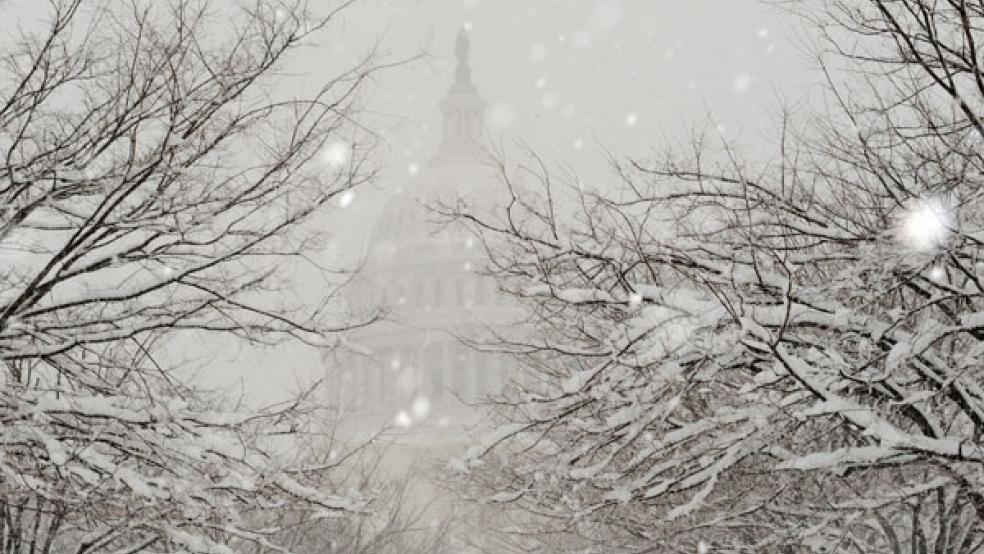Following the build-up to what could be a historic cold weather outbreak this week, I have seen adjectives such as “brutal, dangerous, life-threatening, and deadly” to describe the cold temperatures that will grip the nation from the Canadian border to Florida.
The Dakotas and Minnesota have wind chills in the -50 to -60 degree range meaning frostbite can occur on any exposed skin in less than five minutes.
Related: So Cold We Could Be Living on Mars!
Bringing this closer to home, even the Washington, D.C. area could experience the coldest temperatures we’ve felt in two decades. While the air mass will moderate and we’re not expecting the -50 to -60 degree wind chills, we can still expect air temperatures to crash into the single digits and wind chills of -5 to -15 degrees by Tuesday morning.
Preparing Yourself for the Cold
With the most dangerous wind chills expected Monday night and Tuesday morning, here are some tips for dealing with the cold:
- Educate yourself: The best way to protect yourself from the cold is to understand it. The wind chill, or “feels like” temperature, is calculated taking into account the air temperature and wind speed. An air temperature in the single digits with sustained windspeed of 15 mph can mean it can feel like -20 degrees to you. Frostbite can occur to any exposed skin in less than 30 minutes with wind chills in the -20 degree range.
- Know the signs:
- Hypothermia: Hypothermia occurs when the internal body temperature drops below 95 degrees. According to the CDC, signs of hypothermia include shivering, drowsiness, confusion, slurred speech, and memory loss. While infants and the elderly are most prone to hypothermia, everyone is at risk.
- Frostbite: Frostbite is literally frozen skin. The early signs of frostbite include redness of the skin and pain. Advanced signs include a whitening/greying or yellowing of the skin, skin that feels very firm or waxy, and numbness.
- Have a plan and an emergency cold kit: The best defense is a good offense. Have an emergency kit ready with any necessary supplies specific to handling cold temperatures including: extra batteries (batteries drain faster in the cold), extra blankets and/or sleeping bags, a fire extinguisher, carbon monoxide detector, etc.
- See this full checklist of the do’s and don’ts for riding out the cold, from the CDC.
Related: 16 Unbelievably Cool Ice Sculptures
Preparing Your Pets for the Cold
We cannot forget our beloved furry friends in times of extreme cold weather. Despite having fur, they can be affected by the cold just as quickly as we can. Here are some great tips from the ASPCA:
- DO NOT leave them outside. Even if they are normally outdoor pets, bring them inside. They will freeze to death in this cold. If you see an animal stuck outside, call the authorities immediately.
- When walking your dog, keep them on a leash to prevent the dog from running away or getting lost. Scents are lost in the cold (and especially with snow on the ground) so dogs can easily lose their way.
- Keep pet beds off the floor or away from doors and windows where cold air can settle or cold drafts can exist. Provide a warm blanket or pillow to keep them warm.
- This should go without saying, but do not leave your pet in a vehicle during the extreme cold. Cold air can get trapped in a car like a freezer.
- Know the signs of hypothermia and frostbite:
- Hypothermia: Dogs and cats shiver just like we do, and they may appear very lethargic or not seem interested in food.
- Frostbite: Ears and paws are most prone to frostbite. The tips of the ears may become red or hard indicating early signs of frostbite. Paws will also become increasingly red, and they may lick them indicating numbness, pain, or sensitivity.
- A good rule of thumb: If it’s too cold for you, it’s too cold for your pet.
Related: The Best and Worst Airports for Winter Travel
Preparing Your Home for the Cold
Your home is where you will most likely be riding out the cold temperatures, so here are some tips to make sure your house is prepped to handle the cold:
- To prevent pipes from freezing, keep cabinet doors open and allow faucets to drip.
- Drain or disconnect any outdoor faucets or hoses to prevent freezing.
- Keep generators outside and at least 20 feet way from your home to prevent carbon monoxide poisoning.
- Install carbon monoxide detectors on every floor of your home.
- Keep your thermostat at a steady temperature and no colder than 55 degrees.
- While it may be tempting, avoid using candles to prevent a house fire.
- Covering windows with plastic on the inside can help insulate your home and prevent cold drafts.
- Make sure your chimney is clean before burning wood.
- Keep portable heaters at least 3 feet away from bedding, curtains, drapes, etc. to prevent fires.
- Do not use portable gas camp stoves or charcoal grills inside due to deadly fumes.
- Fill a bathtub with water in the event water mains break.
- Thaw any frozen pipes with a hair dryer, NOT a torch or flame source.
Pro tip: With the deep freeze coming, now is the time to protect against frozen pipes.
Preparing Your Vehicle for the Cold
Preparing your car for the cold is also extremely important in the extreme cold. This includes preparations to prevent your car from breaking down on the road, to having an emergency kit in the event you are stranded.
- Keep your car in the garage if applicable.
- Make sure you have a full tank of gas to avoid freezing or ice on the fuel lines.
- Check antifreeze and windshield wiper fluid levels.
- Clean battery terminals to reduce the risk of a dead car battery.
- Must-have items in a car emergency kit include:
- Extra warm clothes (gloves, hats, socks), blankets and/or sleeping bags
- Emergency flares
- Extra batteries
- Bottled water and snacks
- Booster cables, tow chain, or rope
- Flourescent distress flag
- An airhorn or siren
Pro tip: Mittens will keep your hands warmer for longer than gloves due to direct skin contact between all five fingers.
Conclusion
The National Weather Service Twin Cities office is calling this cold outbreak a “Particularly Dangerous Situation,” verbiage almost exclusively reserved for severe weather outbreaks such as tornado outbreaks. Nearly three-quarters of the country will fall under the grip of this historic cold, what many National Weather Service offices are saying is the coldest air many have felt in 20-30 years. Take the above tips to protect yourself, your pets, your home, and vehicle from the extreme cold…and think warm thoughts!
…and in our nation’s capital this week, the Capitol building may look and feel like the world’s largest igloo.
Additional Resources:
Center for Disease Control
Red Cross
National Weather Service
This article originally appeared in The Washington Post.
Read more from The Washington Post:
Koch-Backed Political Network Built to Shield Donors
Liz Cheney to End Wyoming Bid, Citing Family Health Issues
Janet Yellen Confirmed As Next Federal Reserve Chief





